User:Ichthyovenator/List of Roman emperors2
The Principate (27 BC–235)
[edit]The chronology and the emperors represented below follows the commonly accepted line of legitimate senior emperors, as per Levick (1985)[1] and Elton (1825).[2]
Julio-Claudian dynasty (27 BC–68)
[edit]Year of the Four Emperors (68–69)
[edit]Flavian dynasty (69–96)
[edit]Nerva-Antonine dynasty (96–192)
[edit]Year of the Five Emperors (193)
[edit]Severan dynasty (193–235)
[edit]Crisis of the Third Century (235–285)
[edit]The Crisis of the Third Century saw the rise and fall of many usurpers, some of which successfully took control of the empire and became legitimate emperors. The chronology and the emperors represented below follows the commonly accepted line of legitimate senior emperors, as per Levick (1985),[1] Elton (1825)[2] and Grant (1999).[3]
Barracks emperors (235–268)
[edit]Illyrian emperors (268–285)
[edit]The Dominate (284–518)
[edit]Through most of the period from the late third century to the late fifth century, imperial power was divided into West and East. The chronology and the emperors represented below follows the commonly accepted line of legitimate senior emperors, as per Elton (1825),[4] Goldsworthy (2003)[5] and Haldon (2005).[6] Though imperial power was often divided between West and East, the Roman Empire as a whole was still considered undivided; there were not separate Western and Eastern empires. Instead, the Eastern and Western emperors were simply co-rulers (as there had been at many points before in Roman history), though this time with designated geographical areas of control.[7] To simplify the list, the co-rulers represented for each emperor below are only those junior or senior partners in the part of the empire ruled by that emperor.
Tetrarchy (284–324)
[edit]| Portrait | Name | Reign | Co-ruler(s) | Succession and Notes | Life details | Ref |
|---|---|---|---|---|---|---|

|
Diocletian Gaius Aurelius Valerius Diocletianus (Whole, then east) |
20 November 284– 1 May 305 (20 years, 5 months and 11 days) |
Maximian (Caesar, 21 July 285–1 April 286; co-Augustus, 286–1 May 305) Galerius (Caesar, 21 March 293–1 May 305) |
Former general in service of Carus. Proclaimed emperor by army after death of Numerian, in opposition to Carinus. Sole Augustus upon his victory over Carinus. Created the tetrarchic system of co-rulership. | Born c. 22 December 244 in Salona. Abdicated in favor of Galerius in 305 and died of natural causes near Split on 3 December 311 (aged 66) | [8] |
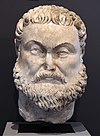
|
Maximian Marcus Aurelius Valerius Maximianus Herculius (West) |
1 April 286 – 1 May 305
(19 years and 1 month)) |
Galerius (Caesar, 21 March 293–1 May 305)
Constantius I Chlorus (Caesar, 1 March 293–1 May 305) |
[9] | ||
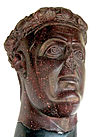
|
Galerius Gaius Galerius Valerius Maximianus (East) |
1 May 305– 5 May 311 (6 years and 4 days) |
Licinius (designated Augustus for the West, 11 November 308–311)
Maximinus II (Caesar, 1 May 305; co-Augustus, 1 May 310–early May 311) |
[10] | ||
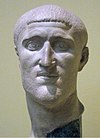
|
Constantius I Chlorus Marcus Flavius Valerius Constantius Herculius (West) |
1 May 305– 25 July 306 (1 year, 2 months and 24 days) |
Valerius Severus (Caesar, 1 May 305 –July 306) | [11] | ||

|
Valerius Severus (also Severus II) Flavius Valerius Severus (West) |
25 July 306 – April 307 (<1 year) |
[12] | |||
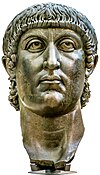
|
Constantine I the Great Flavius Valerius Aurelius Constantinus (West) |
25 July 306– 18 September 324 (18 years, 1 month and 25 days; later emperor of the entire empire 324–337) |
Crispus (Caesar, 1 March 317–326)
Constantine II (Caesar, 1 March 317–337) |
|||
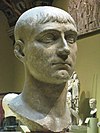
|
Maxentius Marcus Aurelius Valerius Maxentius (West) |
28 October 306– 28 October 312 (6 years) |
Maximian (co-Augustus, 306–308) | [13] | ||

|
Licinius Valerius Licinianus Licinius (West, then east) |
11 November 308– 19 September 324 (15 years, 10 months and 8 days) |
Valerius Valens (designated Augustus for the West, 316–317)
Licinius II (Caesar, 1 March 317–324) |
[14] | ||

|
Maximinus II Daia Galerius Valerius Maximinus (East) |
1 May 310 – summer 313 (2 years) |
Licinius (Augustus, 11 November 308; rival Augustus, 1 May 310–313) |
Constantinian dynasty (324–363)
[edit]| Portrait | Name | Reign | Co-ruler(s) | Succession and Notes | Life details | Ref |
|---|---|---|---|---|---|---|

|
Constantine I the Great Flavius Valerius Aurelius Constantinus (Whole) |
18 September 324– 22 May 337 (12 years, 8 months and 5 days; previously Western emperor 306–324) |
Crispus (Caesar, 317–February 326) Constantine II (Caesar, 317–337) Constantius II (Caesar, 8 November 324–337) Constans I (Caesar, 25 December 333–337) Dalmatius (Caesar, 18 September 335–337) Hannibalianus ("King of Kings" and King of Pontus, 335–337) |
|||

|
Constantine II Flavius Claudius Constantinus (West) |
9 September 337– 340 (3 years) |
[15] | |||
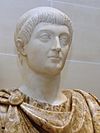
|
Constans Flavius Iulius Constans (West) |
9 September 337– February 350 (12 years and 9 months) |
[15] | |||

|
Constantius II Flavius Iulius Constantius (East, then whole) |
9 September 337– 3 November 361 (24 years, 5 months and 12 days) |
Constantius Gallus (Caesar, 15 March 351–354)
Julian (Caesar, 6 November 355–360, rival Augustus, 360–361) |
[15] | ||

|
Julian the Apostate Flavius Claudius Iulianus (Whole) |
3 November 361– 26 June 363 (1 year, 7 months and 23 days) |
Proclaimed Augustus by his army after the Battle of Strasbourg but refused, 357. Proclaimed Augustus again at Lutetia, 360. | [16] |
| Portrait | Name | Reign | Co-ruler(s) | Succession and Notes | Life details | Ref |
|---|---|---|---|---|---|---|

|
Jovian Flavius Iovianus (Whole) |
27 June 363– 17 February 364 (7 months and 22 days) |
[17] |
Valentinian dynasty (364–392)
[edit]Theodosian dynasty (379–457)
[edit]Final Western emperors & Leonid dynasty (455–518)
[edit]Justinian dynasty (518–602)
[edit]| Portrait | Name | Reign | Co-ruler(s) | Succession and Notes | Life details | Ref |
|---|---|---|---|---|---|---|

|
Justin I Flavius Iustinus |
10 July 518– 1 August 527 (9 years and 23 days) |
Justinian I (junior co-Augustus from 4 April 527) | Of peasant origin and the commander of the Excubitors at the time of Anastasius I's death. Proclaimed emperor thereafter. | Born 2 February 450 in Baderiana, near modern Skopje. Died of natural causes on 1 August 527 (aged 77) | [18][19] |
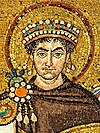
|
Justinian the Great Flavius Petrus Sabbatius Iustinianus |
1 August 527– 14 November 565 (38 years, 3 months and 13 days) |
Theodora (Augusta, often described as co-regent, 527–548) | Nephew and designated successor (as junior Augustus) of Justin I. Already dictated much of imperial policy during his uncle's reign before becoming emperor in his own right. | Born c. 482 in Tauresium. Died of natural causes on 14 November 565 (aged 83) | [18][20] |

|
Justin II Flavius Iustinus Iunior |
15 November 565– 5 October 578 (12 years, 10 months and 20 days) |
Tiberius II Constantine (Caesar and regent, 574–578, co-Augustus from 26 September 578 onwards) | Nephew and designated successor of Justinian I. | Born c. 520. Died of natural causes on 5 October 578 (aged 58) | [21] |

|
Tiberius II Constantine Flavius Tiberius novus Constantinus |
5 October 578– 14 August 582 (3 years, 10 months and 9 days) |
Germanus (Caesar, 582) Maurice (Caesar, 582) |
Commander of the Excubitors, adopted as son and heir by Justin II. | Born c. 520. Died after eating poorly prepared (or perhaps poisoned) food on 14 August 582 (aged 62) | [22] |

|
Maurice Flavius Mauricius novus Tiberius |
14 August 582– 27 November 602 (20 years, 3 months and 13 days) |
Theodosius (Caesar in 587, co-Augustus from 26 March 590 onwards) | Commander of the Excubitors, designated successor of Tiberius II Constantine after being granted Tiberius's daughter's hand in marriage. | Born in 539 in Arabissus. Deposed and executed by Phocas on 27 November 602 (aged 63) | [23] |
After the fall of the Western Roman Empire in the 5th century, Roman rule continued uninterrupted in the east until the eastern empire fell in 1453. Although Greek increasingly replaced Latin as an administrative language and the empire's borders gradually shrunk to encompass only majority-Greek-speaking lands, the citizens and emperors of the eastern empire continually maintained that they were Romaioi (Romans), not Hellenes (Greeks).[24] Nevertheless, modern historiography traditionally views the Eastern Roman Empire of the Middle Ages as a distinct culture and civilization, referring to it as the Byzantine Empire. As the distinction is modern, where the line is drawn between Rome and Byzantium is arbitrary and contentious, with suggested dates ranging from the division of the Roman Empire upon the death of Theodosius I in 395 to the end of Latin inscriptions being used on coins in the early 8th century.[25] As per Craven (2019),[25] this list ends with Maurice and his son and co-emperor Theodosius. The century following Maurice's deposition by Phocas saw a series of events which terminated Roman control of the Mediterranean. Phocas neglected the administration of the empire, decimated the old ruling class and emptied much of the imperial treasury. During the rule of the succeeding Heraclian dynasty, the rise of Islam brought with it the loss of the Levant and North Africa and at the same time, imperial control of Italy, reconquered under Justinian I, began to terminally decline.[25]
- For further Roman emperors in the East, see List of Byzantine emperors
References
[edit]Citations
[edit]- ^ a b Levick 1985, p. 244–245.
- ^ a b Elton 1825, p. 303.
- ^ Grant 1999, p. ix.
- ^ Elton 1825, p. 304.
- ^ Goldsworthy 2003, p. 92.
- ^ Haldon 2005, p. 176.
- ^ Bury 2015, p. 278.
- ^ Cooley, p. 501; DIR, "Diocletian".
- ^ Cooley, p. 501; DIR, "Maximianus Herculius".
- ^ PLRE I, pp. 574–575; Cooley, p. 502.
- ^ Barnes, p. 4; Kienast, p. 280.
- ^ Kienast, p. 290; DIR, "Severus II".
- ^ Kienast, p. 291; DIR, "Maxentius".
- ^ PLRE I, p. 509; DIR, "Licinius".
- ^ a b c Kienast, pp. 310, 312, 314; Barnes, p. 8.
- ^ DIR, "Julian the Apostate"; Keppie, p. 137.
- ^ DIR, Jovian; PLRE I, p. 461.
- ^ a b Cooley 2012, pp. 488–509.
- ^ Sear 1987, p. 44, 51.
- ^ Sear 1987, p. 56.
- ^ Sear 1987, p. 89.
- ^ Sear 1987, p. 89, 104.
- ^ Sear 1987, p. 104.
- ^ Nicol 1992, p. ix.
- ^ a b c Craven 2019, pp. 631–632.
Cited bibliography
[edit]- Barnes, Timothy D. (1982). The New Empire of Diocletian and Constantine. Cambridge, MA: Harvard University Press. ISBN 0-674-28066-0.
- Bury, John Bagnell (2015). A History of the Later Roman Empire from Arcadius to Irene (395 A.D. to 800 A.D.). Cambridge University Press. ISBN 9781316219133.
{{cite book}}: CS1 maint: ref duplicates default (link) - Cooley, Alison E. (2012). The Cambridge Manual of Latin Epigraphy. Cambridge University Press. ISBN 978-0-521-84026-2.
- Craven, Maxwell (2019). The Imperial Families of Ancient Rome. Fonthill Media. ISBN 978-1781557389.
{{cite book}}: CS1 maint: ref duplicates default (link) - DIR – De Imperatoribus Romanis
- Elton, Charles Abraham (1825). A History of the Roman Emperors: From the Accession of Augustus to the Fall of the Last Constantine; in Seven Books. Baldwin, Cradock and Joy.
{{cite book}}: CS1 maint: ref duplicates default (link) - Goldsworthy, Adrian (2011) [2003]. The Complete Roman Army. Thames & Hudson. ISBN 978-0500288993.
- Grant, Michael (2012) [1999]. The Collapse and Recovery of the Roman Empire. Routledge. ISBN 978-0-415-17323-0.
- Haldon, John (2005). The Palgrave Atlas of Byzantine History. Palgrave Macmillan. ISBN 978-0230243644.
{{cite book}}: CS1 maint: ref duplicates default (link) - Hammond, Mason (1957). "Imperial Elements in the Formula of the Roman Emperors during the First Two and a Half Centuries of the Empire". Memoirs of the American Academy in Rome. 25: 19–64. JSTOR 4238646.
- Kienast, Dietmar (1996). Römische Kaisertabelle: Grundzüge einer römischen Kaiserchronologie (in German). Wissenschaftliche Buchgesellschaft. ISBN 3-534-13289-0.
- Levick, Barbara (2002) [1985]. The Government of the Roman Empire: A Sourcebook. Routledge. ISBN 0415232376.
- Nicol, Donald M. (1992). The Immortal Emperor: The Life and Legend of Constantine Palaiologos, Last Emperor of the Romans. Cambridge: Cambridge University Press. ISBN 978-0511583698.
{{cite book}}: CS1 maint: ref duplicates default (link) - PLRE I – The Prosopography of the Later Roman Empire Volume 1: A.D. 260–395. A.H.M. Jones & J.R. Martindale & J. Morris eds. Cambridge University Press (1971). ISBN 0-521-07233-6.
- Watson, Alaric (1999). Aurelian and the Third Century. London: Routledge. ISBN 0-415-07248-4.
